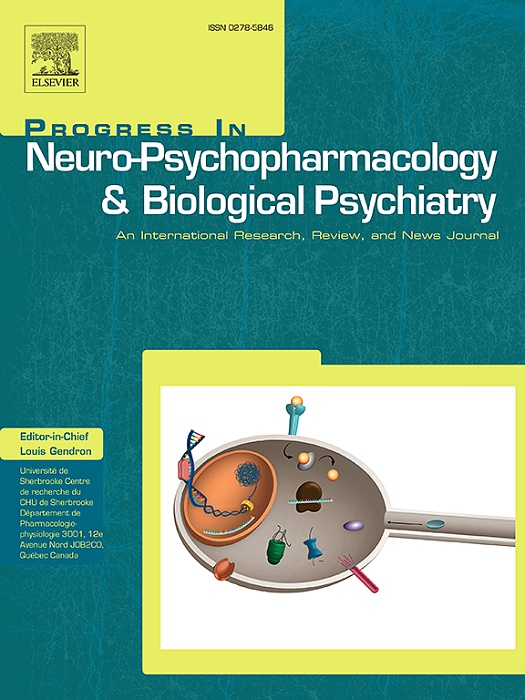Sex-specific association between schizophrenia polygenic risk and subclinical schizophrenia-related traits
IF 3.9
2区 医学
Q1 CLINICAL NEUROLOGY
Progress in Neuro-Psychopharmacology & Biological Psychiatry
Pub Date : 2024-10-04
DOI:10.1016/j.pnpbp.2024.111161
引用次数: 0
Abstract
Background
According to the dimensional view of psychiatric disorders, psychosis is expressed as a continuum in the general population. However, the investigation of the putative genetic aetiological continuity between its clinical and subclinical phenotypes has yielded mixed results. We aimed to replicate previous findings regarding the association of polygenic risk for schizophrenia with subclinical traits (i.e., schizotypy traits and psychotic-like experiences), and to examine the role of sex in this association in a large nonclinical sample.
Methods
The Multidimensional Schizotypy Scale and the Community Assessment of Psychic Experiences were assessed in 919 nonclinical participants. Polygenic Risk Scores for schizophrenia (SZ-PRSs) were computed using the PRS-CS method based on the latest genome-wide association study of schizophrenia. Summary statistics derived from the total GWAS sample and stratified by sex were used. Linear regression analyses tested the associations of the SZ-PRSs with the psychometric variables, both in the total sample and by sex.
Results
No associations were found between the SZ-PRSs and the positive, negative or disorganized dimensions of schizotypy in the total sample. Likewise, no associations were found with psychotic-like experiences. However, the sex-stratified analyses revealed a male-specific association with positive schizotypy. Similar results were obtained with the PRSs derived from the sex-stratified summary statistics.
Discussion
Our results are consistent with the lack of clear evidence of an association between SZ common genetic risk and its subclinical phenotypes. Nevertheless, the male-specific association found suggests that this PRS might explain better the male phenotype, as reported in previous studies. Future studies should put a focus on the role of sex in this association to unravel its sex specificities.
精神分裂症多基因风险与亚临床精神分裂症相关特征之间的性别特异性关联。
背景:根据精神疾病的维度观点,精神病在普通人群中表现为一个连续体。然而,对其临床和亚临床表型之间假定的遗传致病连续性的研究结果不一。我们的目的是复制之前关于精神分裂症多基因风险与亚临床特征(即分裂型特征和精神病样经历)相关性的研究结果,并在一个大型非临床样本中研究性别在这种相关性中的作用:方法:对 919 名非临床参与者进行了多维精神分裂症量表(Multidimensional Schizotypy Scale)和精神体验社区评估(Community Assessment of Psychic Experiences)的评估。根据最新的精神分裂症全基因组关联研究,采用PRS-CS方法计算出精神分裂症多基因风险评分(SZ-PRS)。我们使用了从全基因组关联研究样本中得出的汇总统计数据,并按性别进行了分层。线性回归分析检验了总样本和按性别分列的 SZ-PRS 与心理测量变量之间的关联:结果:在所有样本中,SZ-PRSs 与精神分裂症的积极、消极或混乱维度之间均未发现关联。同样,SZ-PRS 与精神病样经历也没有关联。然而,性别分层分析表明,阳性精神分裂症与男性有特异性关联。根据性别分层汇总统计得出的PRS也得到了类似的结果:讨论:我们的研究结果与缺乏明确证据表明精神分裂症的常见遗传风险与其亚临床表型之间存在关联的观点一致。然而,我们发现的男性特异性关联表明,正如之前的研究报告所述,该PRS可能能更好地解释男性的表型。未来的研究应关注性别在这种关联中的作用,以揭示其性别特异性。
本文章由计算机程序翻译,如有差异,请以英文原文为准。
求助全文
约1分钟内获得全文
求助全文
来源期刊
CiteScore
12.00
自引率
1.80%
发文量
153
审稿时长
56 days
期刊介绍:
Progress in Neuro-Psychopharmacology & Biological Psychiatry is an international and multidisciplinary journal which aims to ensure the rapid publication of authoritative reviews and research papers dealing with experimental and clinical aspects of neuro-psychopharmacology and biological psychiatry. Issues of the journal are regularly devoted wholly in or in part to a topical subject.
Progress in Neuro-Psychopharmacology & Biological Psychiatry does not publish work on the actions of biological extracts unless the pharmacological active molecular substrate and/or specific receptor binding properties of the extract compounds are elucidated.

 求助内容:
求助内容: 应助结果提醒方式:
应助结果提醒方式:


